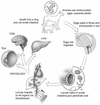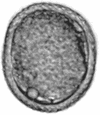Toxocariasis: clinical aspects, epidemiology, medical ecology, and molecular aspects
- PMID: 12692098
- PMCID: PMC153144
- DOI: 10.1128/CMR.16.2.265-272.2003
Toxocariasis: clinical aspects, epidemiology, medical ecology, and molecular aspects
Abstract
Toxocariasis is caused by a series of related nematode species (ascarids) that routinely infect dogs and cats throughout the world. The eggs from these ascarids are common environmental contaminants of human habitation, due largely to the fact that many kinds of dogs and cats serve as pets, while countless others run wild throughout the streets of most urban centers. The eggs, present in dog and cat feces, become infectious within weeks after they are deposited in the local environment (e.g., sandboxes, city parks, and public beaches, etc.). Humans, particularly children, frequently ingest these eggs by accident and become infected. Infection in humans, in contrast to their definitive hosts, remains occult, often resulting in disease caused by the migrating larval stages. Visceral larva migrans (VLM) and ocular larva migrans (OLM) are two clinical manifestations that result in definable syndromes and present as serious health problems wherever they occur. Diagnosis and treatment of VLM and OLM are difficult. These issues are summarized in this review, with emphasis on the ecology of transmission and control of spread to both humans and animals through public health initiatives employing treatment of pets and environmental intervention strategies that limit the areas that dogs and cats are allowed within the confines of urban centers.
Figures








References
-
- Arango, C. A. 1998. Visceral larva migrans and the hypereosinophilia syndrome. S. Med. J. 91:882-883. - PubMed
-
- Badley, J. E., R. B. Grieve, and D. D. Bowman. 1987. Immune-mediated adherence of eosinophils to Toxocara canis infective larvae: the role of excretory-secretory antigens. Parasite Immunol. 9:133-143. - PubMed
-
- Basualdo, J. A., M. L. Ciarmela, P. L. Sarmiento, and M. C. Minvielle. 2000. Biological activity of Paecilomyces genus against Toxocara canis eggs. Parasitol. Res. 86:854-859. - PubMed
-
- Beaver, P. C., C. H. Snyde, and G. M. Carrera. 1952. Chronic eosinophilia due to visceral larva migrans. Pediatrics 9:7-19. - PubMed
-
- Beer, S. A., G. I. Novosilítsev, and L. I. Melínikova. 1999. The role of the water factor in the dissemination of Toxocara eggs and the spread of toxocariasis in a megalopolis. Parasitology 33:129-135. - PubMed
Publication types
MeSH terms
LinkOut - more resources
Full Text Sources
Other Literature Sources
Miscellaneous

